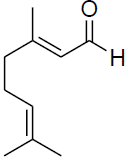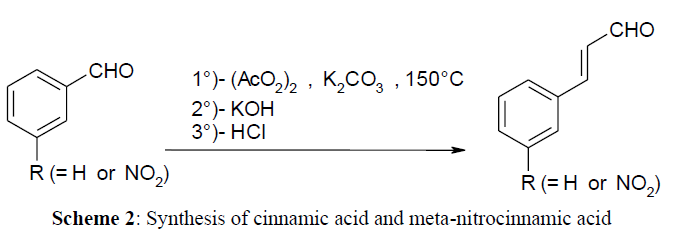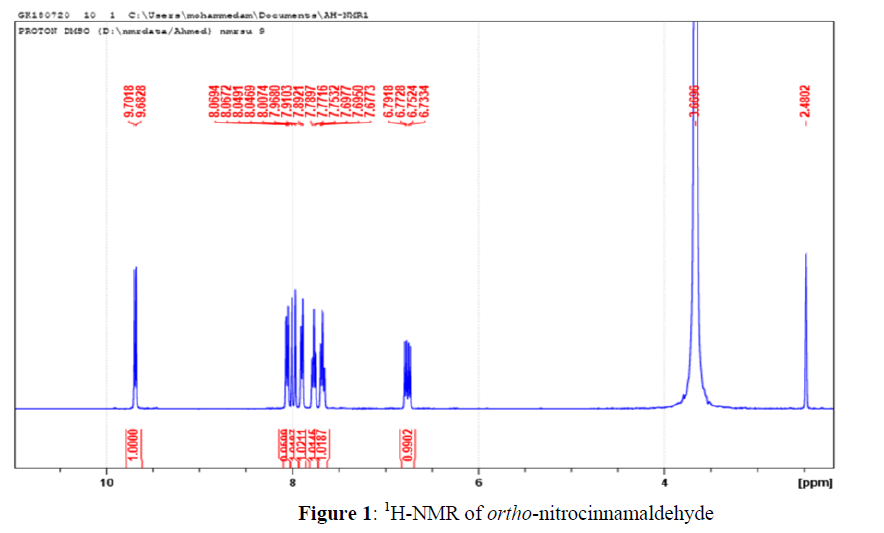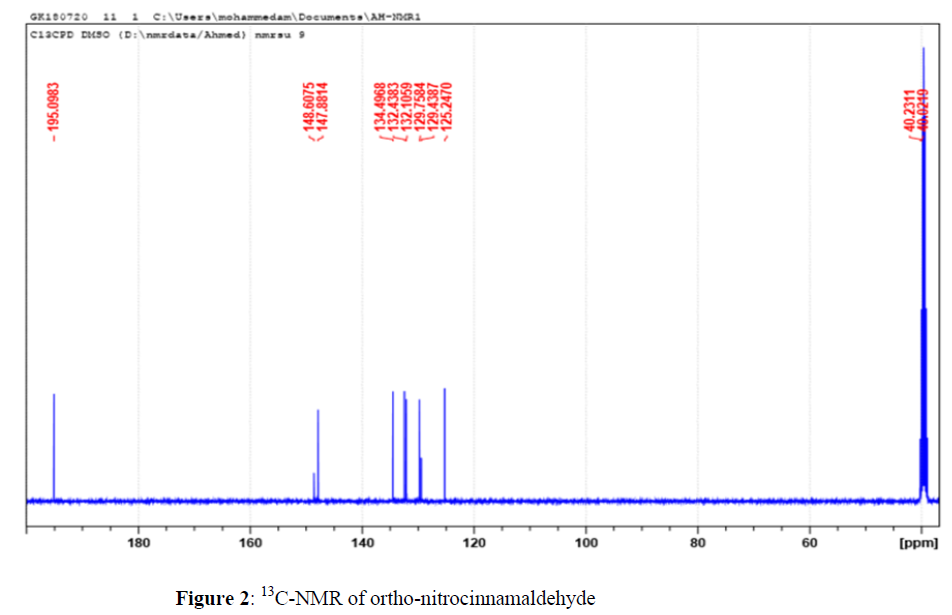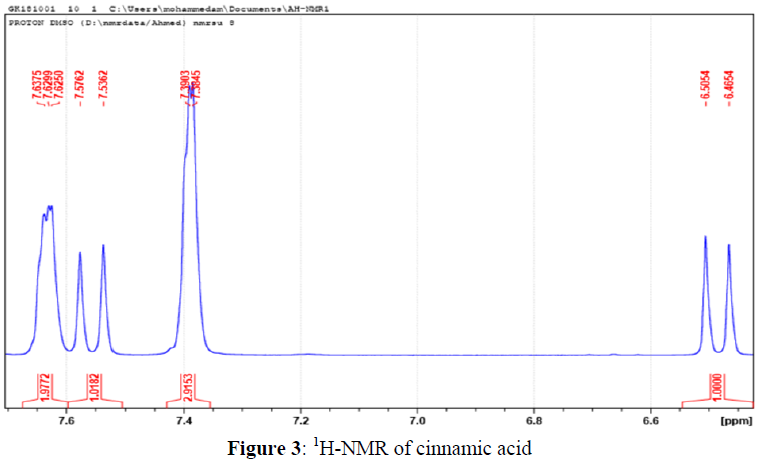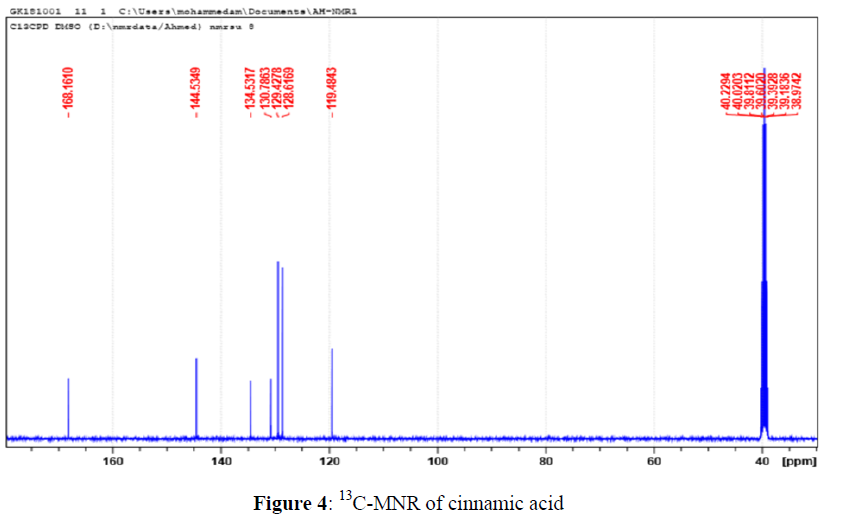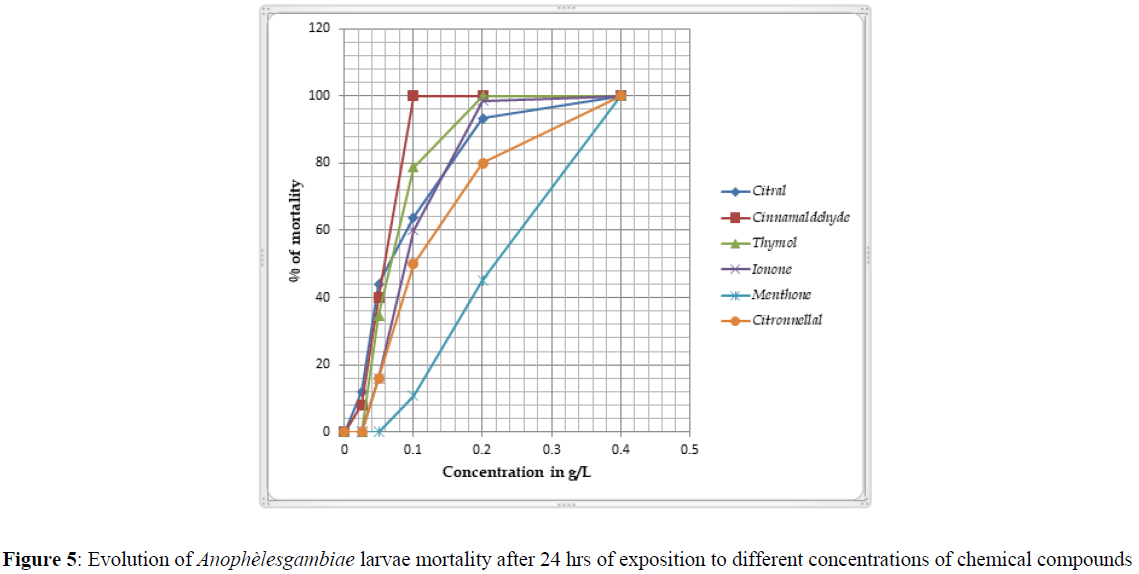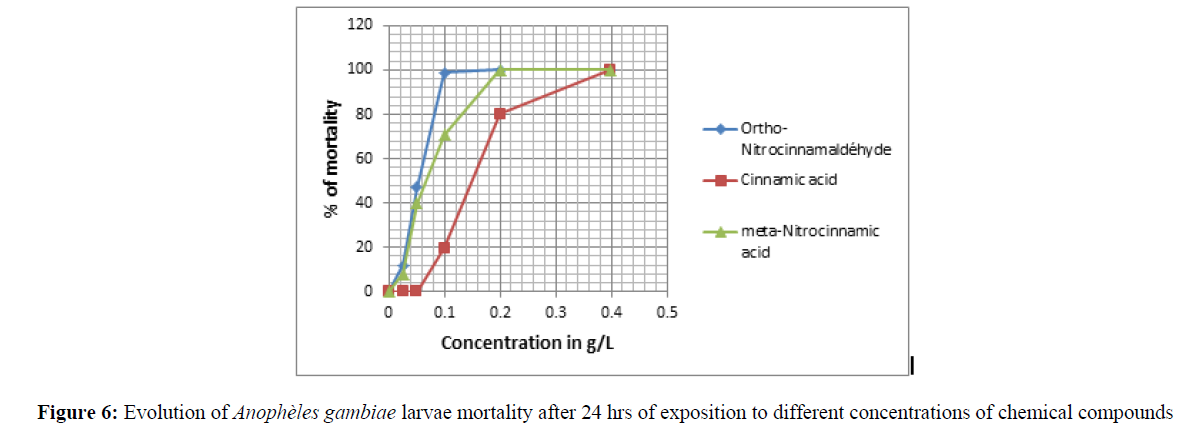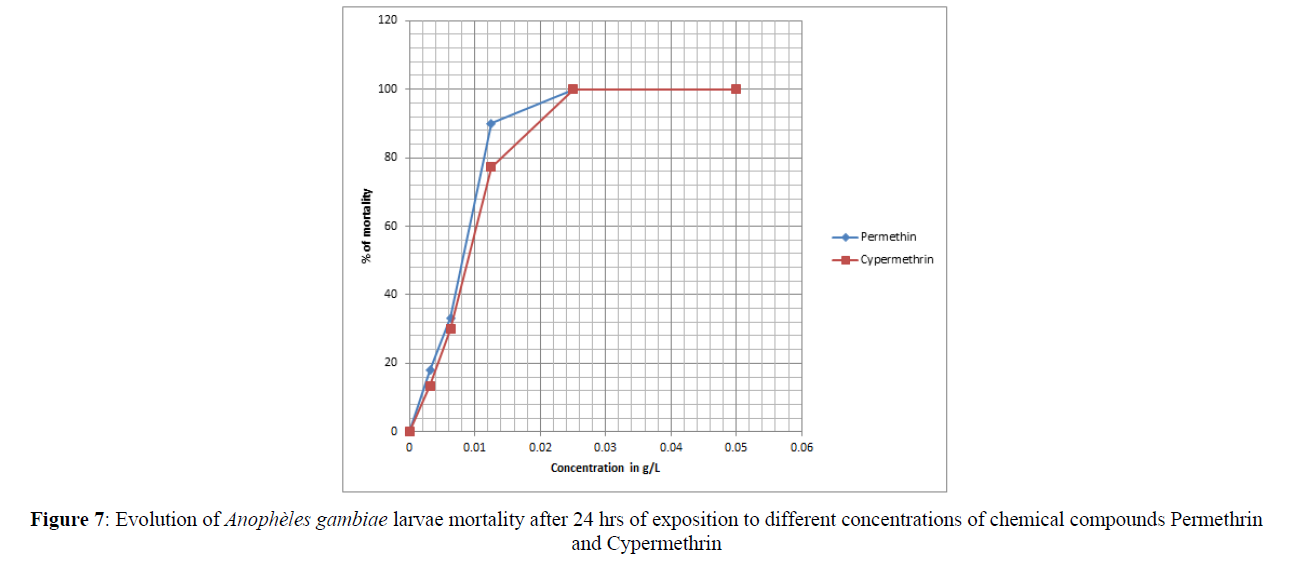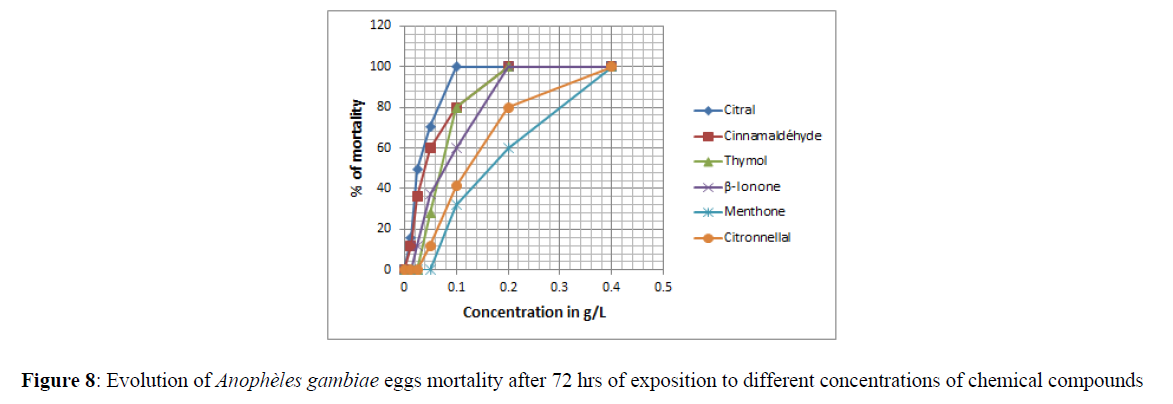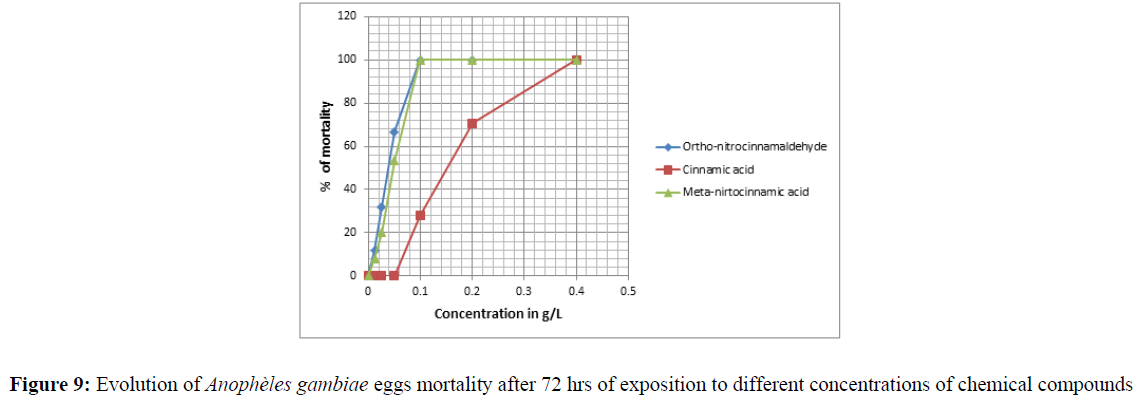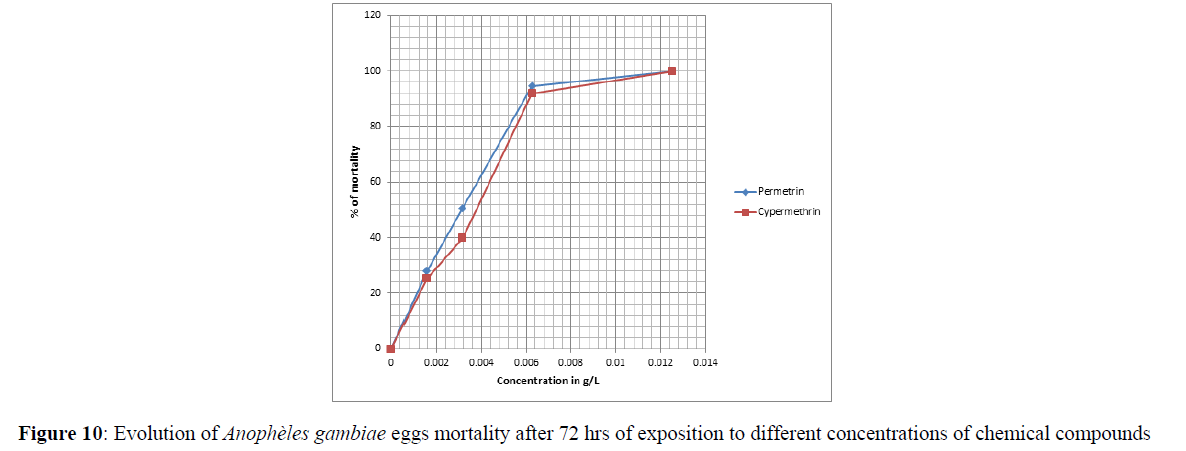Research Article - Der Pharma Chemica ( 2022) Volume 14, Issue 11
Larvicidal and ovicidal activities of some cinnamaldehyde derivatives Against Anopheles gambiae, malaria vector agent
Victor N’goka1,2, Guy Crépin Enoua1, Tony Wheellyam Pouambeka1, Ghislain Kende1,2, Gelase Fredy Nsonde Ntandou3,4, Ninon G.E.R. Etsatsala4* and Ouamba Jean-Maurille42Laboratory of Medicinal Chemistry and Pharmacotechnie of Medicinal Plants, CHIRED-CONGO 81, Dahomey Street Poto-Poto,Brazzaville B.P. 13.922, Republic of the Congo
3Laboratory of Biochemistry and Pharmacology, Faculty of Health Sciences, Marien Ngouabi University, Brazzaville B.P. 69, Republic of the Congo
4Department of Horticultural Sciences, Applied Sciences Faculty, Cape Peninsula University of Technology, Symphony Road, Bellville, Cape Town 7535, South Africa
Ninon G.E.R. Etsatsala, Department of Horticultural Sciences, Applied Sciences Faculty, Cape Peninsula University of Technology, Symphony Road, Bellville, Cape Town 7535, South Africa, Email: etsassalan@cput.ac.za
Received: 23-Oct-2022, Manuscript No. dpc-22-80955; Editor assigned: 25-Nov-2022, Pre QC No. dpc-22-80955; Reviewed: 09-Dec-2022, QC No. dpc-22-80955; Revised: 12-Dec-2022, Manuscript No. dpc-22-80955; Published: 19-Dec-2022, DOI: 10.4172/0975-413X.14.11.25-33
Abstract
This study presents the research studies conducted on vector control for the fight against malaria, a very devastating disease with a high rate of mortality and morbidity in sub-Saharan Africa. Following an ethnobotanical, ethnopharmacological, chemical analysis, larvicidal and ovicidal activities of essential oils as well as their main chemical constituents; eleven compounds including related derivatives have been either purchased or synthesized and evaluated for their larvicidal and ovicidal activities. Cinnamaldehyde and o-Nitrocinnamaldehyde exhibited the highest activity withLC50 = 55 mg /L following by Citral (LC50 = 64 mg /L), Cinnamic acid (LC50 = 65 mg /L), and Thymol (L50 = 67 mg /L), against larvaes. Furthermore, Citral, and Cinnamaldhyde showed the highest activity against eegs, with LC50 = 0,015 and 0.020 respectively. This study revealed that the compounds were more active than their corresponding essential oils. Finally, this research study also showed that it would be important to carry out a more in-depth study of the structure activity relationship on chemical constituents or derivatives of essential oils, to improve the activities.
Keywords
Cinnamaldehyde derivatives; Essential oil constituents; Larvicidal; Ovicidal activities
INTRODUCTION
Malaria remains one of the most devastating endemics in black Africa since time immemorial. It is caused by a Hemococcidae of the genus Plasmodium, transmitted to humans by a female mosquito of the genus Anopheles (Ref). The world Health Organization (WHO) statistically reported that an approximation of 627000 deaths related to malaria occurred in 2020, of which 96%were recorded in Africa. Additionally, children under 5 years and pregnant women were the most vulnerable segment of the population [1].
Several efforts have been made to combat this disease, including the use of vector control and other products such as DDT, which ended up being ban because of their detrimental effects on the environment [2-5]. However, resistance to antimalarials drugs has been observed for the past decade and we are gradually returning to vector control, with low environmental effects through intensive research on biopesticides [6-8].Thus, several works investigated the activities of essential oils against Anopheles gambiae [9-15]. Mdoe et al. 2014 reported that the essential oils of Cinnamomum osmophloeum exhibited high mortality of A. gambiae s.s. third instar larvae dosage and time dependant in both laboratory and semi-field trials [9]. Furtheremore, several other authors including Bossou, et al. 2013, reported that the essential oils from Cymbopogon. Citrates have insecticidal properties against the vector of malaria, Anopheles gambiae[10].
The use of pesticides derived from plant materials may create another problem with regard to the conservation of biodiversity. Indeed, it seems impossible to reconcile the high demand for raw materials of plant origin for industry and the respect of conventions and treaties on the conservation of biodiversity [16]. The history of malaria tells us that the first natural drug was quinine, which gave rise to chloroquine [17]. Antibiotic therapy also began with molecules from biosynthesis to arrive at synthetic antibiotics [17]. Literature shows that monoterpenes have activities against insects such as Aedes aegypti, Culex pipiens and Anopheles gambiae [18-21]. Newman et al reported on a 20, 25 and 30 years statistical studies comparing natural, hemiisynthetic and synthetic products. The founding of these studies showed that industrial products are predominantly synthesis molecules [22-24]. The history of the evolution of antimalarial and antibiotic drugs has shown that the natural substance led to the synthetic product (quinine and chloroquine for example). In addition, studies by Newman et al. show that a lot of drugs in the market have synthetic origin. Several studies have shown that synthetic monoterpenes are more active than the essential oils from which they come.
This research focused on the choice of synthetic molecules as chemical constituents of essential oils, and secondly on the evaluation of their larvicidal and ovicidal activities. The outcomes of this research study are directed to the finding of more bioactive compounds with significant quantity.
EXPERIMENTAL SECTION
Materials and methods
All chemicals and solvents were purchased from VWR-France. The melting points of synthesized compounds were determined in Kofler bank and are uncorrected. Thin layer chromatography (TLC) plate (silica gel G) were purchased from Merck and various solvents such as toluene, acetone, ethanol were used or combined to obtained the more effective and prominent solvent systems. Finally, the UV lamps were used to visualize the TLC plate at two different wavelengths: 254 and or 365 nm. The NMR spectra were carried out on an Avance 400 MHz spectrometer (Bruker, Rheinstetten, Germany), using deuterated dimethylsulfoxide.
Study area
This research project was conducted in 2020 in CHIRED – CONGO at the laboratory of medicinal chemistry and pharmacotechnie of medicinal plants, B.P: 13.922 Brazzaville, Republic of Congo and at the Plant and Life Chemistry Unit, Faculty of Sciences and Techniques, Marien Ngouabi University, Brazzaville BP 69.
Chemical structures of selected compounds
Table 1 described the molecular structures of Citral, cinnamaldehyde, thymol, Ionone, menthone, citronellal, O-Nitrocinnamaldehyde, cinnamic acid, m-Nitrocinnamic acid, Permethrin and Cypermethrin.
| Name | Chemical structure | Name | Chemical structure |
|---|---|---|---|
| Citral |
|
Cinnamaldehyde | 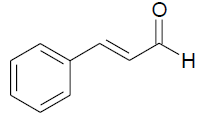 |
| Citronnellal | 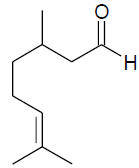 |
O-Nitrocinnamaldehyde | 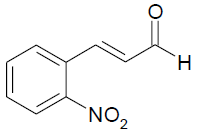 |
| Thymol | 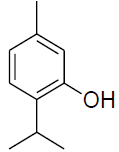 |
Cinnamic acid | 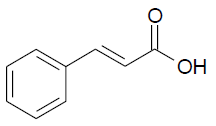 |
| Ionone | 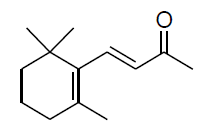 |
Nitrocinnamic acide | 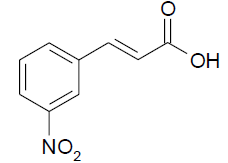 |
| Menthone | 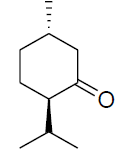 |
Permethrine | 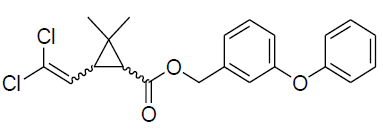 |
| Cypermethrine | 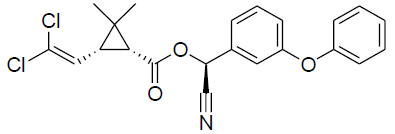 |
General Procedure for the Synthesis of chemical compounds (Scheme 1)
A mass of 2.6 g (20 mmol) of cinnamaldehyde was placed in a 500 mL three necked round bottom flask. 25 mL of acetic anhydride was added to the flask. The balloon was put in an ice with salt bath, and then placed on a magnetic stirrer. A volume of 1 mL of nitric acid and 2.5 mL of sulphuric acid was added and stirred for further 18 min, then for 2 h on the ice bath. The solution was allowed to cool down for 48 hours, and, the solution of concentrated hydrochloric acid was added to the reaction medium and allow to cool down to reveal the crystals. The precipitate obtained was filtered and dried. The product was recrystallized in ethanol to obtain pure O-nitrocinnamaldehyde.
Synthesis of cinnamic acid [26] and meta-nitrocinnamic acid [27] (Scheme 2)
An amount of 3.75 g of anhydrous potassium carbonate and 12.5 mL (130 mmol) of acetic anhydride were placed in a properly equipped 250 mL three necked round bottom flask. The reaction medium was shacked, and 85 mmol of the corresponding aldehyde was added. The temperature of the mixture was increased to 150ºC for 1 hour and 15 minutes while checking the foam. In a 500 mL beaker placed in an ice bath, prepare a solution of 14 g potassium hydroxide in 120 mL of water. After cooling slowly, the still warm to the reaction mixture (about 100°C) was pour into the beaker held in the ice bath. The solution was washed 2 times with 20 mL of diethyl ether. Acidify the aqueous phase with concentrated hydrochloric acid up to pH at about 1. Cool to a temperature below 10°C. The raw cinnamic acid was filtered on Buchner, then washed with cold water and recrystallized in water/ethanol mixture (2-1).
Production of Anopheles gambiae’s eggs
The larvae of Anopheles gambiae were collected at the edge of the river Tsiémé, in Ouenzé - Brazzaville. These larvae were transported to the Faculty of Sciences and Technologies, where they were fed with non-creamy cookies for 4 days, in a cubic cage, 60 cm sides, surrounded by a non-impregnated mosquito net on their face, so that adult mosquitoes from the emergence of the larvae do not escape. Several kinds of cotton soaked in glucose solution were placed in the mosquito cage so that they could feed. After 3 days of feeding, the adult mosquitoes with glucose solution, an anaesthetized rat was introduced into the mosquito cage for 48 hours, so that the fertilized females take their blood meal for the good development of their eggs. After 4 days of the blood meal, mosquito eggs were laid in small plastic tubs, then placed in the mosquito box.
Larvicidal and ovicidal activities
Larvicidal and ovicidal bioassay was carried outas described by Kende et al. [14,15]. Larvicid and ovicide activities have reconciled counts of dead larvae or eggs after exposure to solutions of citral, cinnamaldehyde, thymol,-Ionone, menthone and citronella, ortho-nitrocinnamaldehyde, metanitrocinnamic acid, cinnamic acid, permethrin and cypermethrin. Several 25 larvae of Anopheles gambiae in stage 4 or 25 eggs were introduced into a 5 cm diameter cup containing 80 mL of tested product concentration solution. The concentrations were 0 ppm (control), 12.5, 25, 50, 100, 200 and 400 ppm except for permethrin and cypermethrin where concentrations were 0.05 g/L; 0.025 g/L; 0.0125 g/L; 0.0062 g/L and 0.0031 g/L prepared from 10% commercial solutions. The set is incubated at room temperature for 24 hours for larvae and 72 hours for eggs. All the experiments were repeated three times.The percentage of mortality of larvae was calculated using formula A, while the percentage of mortality of eggs was calculated using formula B, previously described in our previous works [14,15].
RESULTATS ET DISCUSSION
Synthesis of ortho-nitrocinnamaldéhyde
The o-nitrocinnamaldehyde was synthesized by nitration of cinnamaldehyde under the action of nitric-sulphuric acid mixture in acetic anhydrideat 5°C. The product was obtained with a yield of 50 %, purity was confirmed by CCM and the melting point was 126ºC, lit. 126-127,5ºC [25]. C9H7O3N: 177,16 1H-MR (400 Mhz, DMSOd6) : 6.76 (dd, 1H, J=15.8, J=7.6 1H, -CH=CH-CHO), 7.69 (td, 1H, J=7.1, J=1.1, H5-Ar) ; 7.77 (t, 1H, J=7.2, 1H, H4-Ar), 7.90 (d, 1H, J=7.3, H6 Ar), 7.99 (d, 1H, J=15.8, -CH=CH-CHO), 8.06 (dd, 1H, J=8.1, J=0.9, H3 Ar), 9.69 (d, 1H, J=7.6, -CHO); 13C-NMR (DMSOd6): 125.25 ( C3 Ar ), 129.44 (C1 Ar), 129.76 (Ar-CH=CH), 132.10 (C4 Ar), 132.44 (C5 Ar), 134.50 (C6 Ar), 147.88 (C2-NO2), 148.61 (Ar-CH=CH-), 195.10 (-CHO) (Figure 1,2).
Synthesis of cinnamicacid
Cinnamic acid was prepared by the action of acetic anhydride on the corresponding aldehyde in basic medium. The crude obtained after filtration was recrystallized in a water/ethanol mixture (2-1). The founding obtained was presented as followed: white powder, m.p. = 132° C; lit. 133°C[26], yield 35 %, C9H8O2 148,16. 1H-NMR (400 MHz, DMSOd6): 6.48 (d, 1H, J = 16.00, Ar-CH=CH-), 7.3-7.5 (m, 3H, H3, H4, H5 Ar), 7.55 (d, 1H, J=16.00, Ar-CH=CH-), 7.6-7.75 (m, 2H, H2 et H6). 13C-NMR (DMSOd6): 119.48 (Ar-CH=CH-), 128.62 (C2 and C6 Ar), 129.43 (C3 and C5 Ar), 130.79 (C4 Ar), 134.53 (C1 Ar), 144.53 (Ar-CH=), 168.16 (-COOH) (Figures 3,4).
Larvicidal activities against Anophelesgambiae
Table II showed the percentage of mortalityof larval of Anopheles gambiae after 24 hours of exposure to different concentrations of Citral, cinnamaldehyde, thymol, Ionone, menthone, citronella, O-Nitrocinnamaldehyde, cinnamic acid, m-Nitrocinnamicacid, Permethrin and Cypermethrin (Table 2).
| Concentrations of chemical compounds | |||||||
|---|---|---|---|---|---|---|---|
| Name of chemical compounds | 0,4 g/L | 0,2 g/L | 0,1 g/L | 0,05 g/L | 0,025g/L | 0 g/L | CL50 en g/L |
| Citral | 100±0,0% | 93,33±1,67% | 64±0,0% | 44,0±0,0% | 0,0±0% | 0% | 0,064 |
| Cinnamaldéhyde | 100±0% | 100±0,0% | 100±0,0% | 44,0±0,0% | 12,0±0,0% | 0% | 0,055 |
| Thymol | 100±0,0% | 100±0,0% | 78,67±0,88% | 34,67±1,67% | 0,0±0% | 0% | 0,067 |
| Ionone | 10±0,0% | 98,67±0,0% | 60,0±0,0±% | 16,0±0,0% | 0,0±0,0% | 0% | 0,090 |
| Menthone | 100±0,0% | 45,33±1,77% | 10,67±0,88% | 0,0±0,0% | 0,0±0,0 | 0% | 0,100 |
| Citronnellal | 100±0,0% | 80±0,0% | 50,06±1,77% | 16,0±0,0% | 0,0±0% | 0% | 0,210 |
| O-Nitrocinnamaldéhyde | 100±0,0% | 100±0,0% | 98,68±1,77% | 46,58±2,22% | 12±0,0% | 0% | 0,055 |
| Cinnamic acid | 100±0,0% | 80±0,0% | 20±0,0% | 0,00% | 0,00% | 0% | 0,065 |
| m-Nitrocinnamic acid | 100±0,0% | 100±0,0% | 70,67±1,77% | 40±0,0% | 00,00% | 0% | 0,150 |
| Concentrations of chemical compounds | |||||||
| Name of chemical compounds | 0,025g/L | 0,0125g/L | 0,00625g/L | 0,003125g/L | 0 g/L | CL50 en g/L | |
| Permethrin | 100% | 90,00 % | 33,33±0,89 % | 18,0±0,00% | 0% | 0,011 | |
| Cypermethrin | 100% | 77,33±1,77% | 30,0±0,00 % | 13,33±0,89% | 0% | 0,012 | |
There is a dose-dependent evolution of the larvicidal character of the tested compounds at different concentrations. In general, all these compounds prevented larval emergence into adults and caused larval death at a concentration of 0.4 g/L.This result is consistent with the reported work of Antonioset al., Eliningaya et al. and Gad et al. [19-21]. And, Antonios et al. observed that oxygen-containing functions were important for maintaining good activity. However, our results exhibited theLC50 values for the larvicidal activity ranging from 0.055 to 0.210 g/L. Cinnamaldehyde and ortho-Nitrocinnamaldehyde are the most toxic to Anopheles gambiae larvae, with the same LC50 of 0.055 g/L; followed by Citral (0.064g/L), Cynnamic acid (0.065g/L) and Thymol (0.067 g/L), respectively.It is noteworthy to note that at the concentration of 0.1 g/L, cynnamaldehyde demonstrated 100% toxicity followed by Ortho-Nitrocinnamaldehyde 98.68%, whereas Meta-Nitrocynnamic acid and Cinnamic acid only killed 70.67% and 20% of the larvae, respectively. It can be observed that the aldehyde function is important for this activity demonstrated because the change from aldehyde to acid causes a variation in activity of 100% to 20% with respect to observed results for the concentration of 0.1 g/L. Citral and Citronella differed in their structure only on the saturation of the ethylene bond in alpha of the aldehydic function. However, the LC50 value ofCitral is 0.064 while the LC50 of Citronnelalis 0.210. Hence,there is a decrease in activity for factor three following a simple addition of two hydrogen atoms. The investigation of numerous essential oils including Zingiber officinale, and Cymbopogon citrates containing Citral, Cinnamaldehyde and thymol was carried out and the larvicide assessment of these oils showed the LC50 of 0.11 g/L and 0.19 g/L respectively (Kende G. et al., 2019).It can be concluded that the activities of these essential oils are justified by the presence of these chemical compounds. Additionally, when comparing the LC50 values of Zingiber officinale (0.11 g/L), and Cymbopogon citratus (0.19 g/L ) with the LC50 of citral (0.064g/L), it was found that the activity of citralis approximatively twice higher than an essential oils containing them. The same finding was recorded for Cinnamaldehyde with the LC50 value of 0.055 g/L whilethe LC50 value of the essential oil where it is present was 0.11 g/L. Here again, the activity exhibited by Cinnamaldehyde is twice higher than the essential oil containing it. The same observation was also recorded for thymol (LC50 = 0.067 g/L), which is a compound present in Lippiamultiflora oil (LC50 = 0.13 g/L), and the LC50 of Thymol was also twice higher than the one for Lippia multiflora oil.
The LC50 for Cinnamaldehyde, ortho-nitrocinnamaldehyde, cinnamic acid and meta-nitrocinnamic acid are 0.055, 0.055, 0.065 and 1.150, respectively. It can be observed that the introduction of a nitro substituent in position C-2 of Cynnamaldehyde does not modify the activity. However, the replacement of aldehyde function by carboxylic acid function decreases the activity. The introduction of a nitro group in the meta position of the acid decreases the activity three times compared to aldehyde and more than double compared to Cinnamic Acid.
Based on all the observation, it can be concluded that essential oils are good sources of leading molecules for the research of biopesticides and or synthetic pesticides. This assertion is also confirmed by a series of studies on the bibliography described by David J. Newmanal. in 2003, 2007 and 2012, over a period of 20, 25 and 30 years of research, which showed that synthetic products are essential and a safe source of raw materials for industry and trade [22-24]. But also,it has been established that plants, by their biodiversities, are a reliable source of molecular diversity for the research of bioactive molecules (Figure 5-7).
With an LC50 value of 0.011 g/L and 0.012 g/L for permethrin and cypermethrin respectively.The larvicide activity of these reference compounds is 8 times higher than that of the essential oils, and about 5 times higher that of other compounds present in essential oils or their derivatives.
Ovicidal activities against Anophelesgambiae
Table 3 shows the percentage of mortality of Anopheles gambiae eggs after 72 hours of exposure to different concentrations of Citral, cinnamaldehyde, thymol, Ionone, menthone, citronella, O-Nitrocinnamaldehyde, cinnamic acid, and m-Nitrocinnamic acid (Table 3).
| Concentrations of chemical compounds | |||||||||||||
|---|---|---|---|---|---|---|---|---|---|---|---|---|---|
| Name of chemical compounds | 0,4 g/L | 0,2 g/L | 0,1 g/L | 0,05 g/L | 0,025g/L | 0,0125g/L | 0 g/L | CL50 en g/L | |||||
| Citral | 100% | 100% | 100% | 70,67±2,22% | 49,33±0,44% | 16,0±0,00% | 0% | 0,015 | |||||
| Cinnamaldéhyde | 100% | 100% | 80,0±0% | 60±0,00% | 36,0±0,00% | 12±0% | 0% | 0,020 | |||||
| Thymol | 100% | 100% | 80,0±0% | 28,0±0,0% | 0% | 0,0% | 0% | 0,075 | |||||
| b-Ionone | 100% | 100% | 60,0±0% | 37,33±2,26% | 12,0±0,0% | 0,0% | 0% | 0,060 | |||||
| Menthone | 100% | 60,0±0% | 32,0±0,00% | 0,0% | 0,0% | 0,0% | 0% | 0,165 | |||||
| Citronnellal | 100% | 80±0% | 41,33±1,67% | 12,0±0% | 0,0% | 0,0 | 0,0% | 0,120 | |||||
| O-Nitrocinnamaldéhyde | 100±0,0% | 100±0,0% | 100±0,0% | 66,67±1,7% | 32±0,0% | 12,0±0% | 0% | 0,040 | |||||
| Cinnamic acid | 100±0,0% | 70,67±2,22% | 28±0,0% | 00±0,0% | 0,00% | 0,00% | 0% | 0,150 | |||||
| m-Nitrocinnamic acid | 100±0,0% | 100±0,0% | 100±0,0% | 53,33±1,77% | 20±0,0% | 8,0±0,0% | 0% | 0,050 | |||||
| Concentrations of chemical compounds | |||||||||||||
| Name of chemical compounds | 0,0125g/L | 0,00625g/L | 0,003125 g/L | 0,00156 g/L | 0 g/L | CL50 en g/L | |||||||
| Permethrin | 100% | 94,67±1,77% | 50,66±1,77%% | 28,0±0,00% | 0% | 0,00300 | |||||||
| Cypermethrin | 100% | 92,0 ±0,00% | 40,0±0,00 % | 25,33±1,77% | 0% | 0,00380 | |||||||
fr, the situation seems normal for o-Nitrocinnamaldehyde and m-Nitrocinnamic acid, which show 100% toxicity at the concentration of 0, 1g/L on eggs but respectively 0.98 and 0.7 on larvae. From all the above observation, vector control from the egg would use small amounts of products: less plant material and fewer chemicals. For development purposes, this study shows a reliable alternative for the quantitative and qualitative availability of vector control products that can reduce the exaggerated adverse effects on the environment (Figure 8-10).
CONCLUSION
Our research focuses on vector control in the fight against malaria. After careful examination of the chemical constituents of the essential oils studied, eleven compounds were targeted based on the outcome of our previous work, done on essential oils and their larvicidal and ovicidal activities. The evaluation of the larvicidal and ovicidal activities of these compounds, synthesized in our laboratory or obtained from trade has been carried out.
The results showed that the chemical constituents of essential oils are more active than the corresponding essential oils. The activities observed corroborate with other published research works, which demonstrated that eggs were more sensitive than larvae at doses about 5 times lower. This work has shown that compounds as simple as cinnamic acid or cinnamaldehyde can also be exploited. These chemicals are industrially available and have little impact on the environment as they are potentially biodegradable.
References
- World Health Organization. World malaria report. 2021, p. 263.
- Birkholtz LM, Alano P, Leroy D. Trends in Parasitology. 2022, 38(5): p. 390-403.
- Chan K, Tusting LS, Bottomley C, et al., The Lancet Planetary Health. 2022, 9: p. e257-e269.
- Nocera JJ, Blais JM, Beresford DV, et al., Proc Biol Sci. 2012, 279(1740): p. 3114-3120.
- US - Environmental Protection Agency. 1975.
- Nwankwo A, Chaos, Solitons Fractals. 2021, 142.
- Enayadi AA, Londonni H. PJBS. 2006, 9(7): p. 1265-1270.
- Nwankwo A, Chaos S. Fractals. 2021, 142: p. 110481.
- Mdoe FP, Cheng SS, Msangi S, et al., Parasites & vectors. 2014, 7(1): p. 1-6.
- Bossou AD, Mangelinckx S, Yedomonhan H, et al., Parasites & vectors. 2013, 6(1): p. 1-17.
- Foko DGA, Tamesseand JL, Messi J. Journal of Entomology. 2007, 4(4): p. 299-307.
- Mdoe FP, Cheng SS, Laura L, et al., Parasit Vectors. 2014, 7: p. 426
- Mdoe FP, Cheng SS, Msangi S, et al., Parasit Vectors. 2014, 7: p. 209
- Kende G, Nsondé Ntandou GF. Goka V et al., International Journal of Current Advanced Research. 2019, 8: p. 17586-17588.
- Kende G, N goka V, Nsonde-Ntandou GF. Asian Journal of Applied Sciences. 2022, 15: p. 64-69.
- David B, Wolfender DDias JLA, Phytochemistry Reviews. 2014, 14: p. 299-315.
- Lespagnol A, Chimie des medicaments. 1974, 3: p. 115-119.
- Lucia A, Zerba EH. Parasitol Res. 2013, 112: p. 4267-4272
- Antonios M, Vidali VP, Papachristos DP, et al., Chemosphere. 2014, 96: p. 74-80
- Jweka E, Tamires LC, Pergentino de Sousa D. Asian Pacific Journal of Tropical Biomedicine. 2016, 6: p. 290-294
- Gad HA, Ramadan, GRM, El-Bakry AM et al. Int J Trop Insect Sci. 2022, 42: p. 1059-1075.
- Newman DJ, Gordon CM, and Snader KM. J Nat Prod. 2003, 66: p. 1022-1037.
- Newman DJ, Cragg GM. J Nat Prod. 2007, 70: p. 461-477
- Newman DJ, Cragg GM. J Nat Prod. 2012, 75: p. 311-335.
- Richard TA, James DG. Organic syntheses. 1963, 4: p.722.
- Encyclopaedia Britannica. 1911, p. 376.
- Thayer FK, Organic Syntheses. 1925, 5: p. 83.
Indexed at, Google Scholar, Crossref
Indexed at, Google Scholar, Crossref

